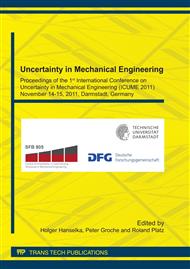[1]
M. Kleiner, M. Geiger, A. Klaus, in Manufacturing of Lightweight Components by Metal Forming, ICED at Paris, (2007).
Google Scholar
[2]
K. Ehrlenspiel, A. Kiewert, U. Lindemann in Kostengünstig Entwickeln und Konstruieren (engl. Cost saving design and development), VDI Buch, (2007).
DOI: 10.1007/978-3-662-08198-3
Google Scholar
[3]
J. Danzberg in Effizienzsteigerung durch innovative Lösungen in der Methodenplanung und im Werkzeugbau (engl: Efficiency increase trough innovative solutions in tooling design), SWISSMEM & IVP, ETH Zürich, (2007).
Google Scholar
[4]
K. Roll in: Simulation der Blechumformung – neue Anforderungen und Tendenzen (engl: Deep- drawing simulation – new requirements and tendencies), Tagungsband 12. Dresdner Werkzeugmaschinen-Fachseminar Simulation von Umformprozessen unter Einbeziehung der Maschinen und Werkzeugeinflüsse, Dresden, (2007).
Google Scholar
[5]
M. Schroeder in: Weitere Potenziale der Topologieoptimierung zur Rückfederungskompensation von Blechformteilen (engl: Further potentials of topology optimization for spring-back compensation of deep-drawn parts), Tagungsband 12. Dresdner Werkzeugmaschinen-Fachseminar Simulation von Umformprozessen unter Einbeziehung der Maschinen und Werkzeugeinflüsse, Dresden, (2007).
Google Scholar
[6]
A. Krasovskyy in Verbesserte Vorhersage der Rückfederung bei der Blechumformung durch weiterentwickelte Werkstoffmodelle (engl: Improved springback forecast of deep-drawn parts trough improved material models), Dissertation Karlsruhe, (2005).
Google Scholar
[7]
E. Dietrich; A. Schulze in Statistische Verfahren zur Maschinen- und Prozeßqualifikation (engl: Statistical methods for machine and process qualification), Carl Hanser Verlag München, Wien, ISBN 3-446-18780-4, (1996).
Google Scholar
[8]
M. Bohn in Toleranzmanagement im Entwicklungsprozess (engl: Tolerance management in the development process), Dissertation Karlsruhe, (1998).
Google Scholar
[9]
K. Roll, T. Lemke, K. Wiegand in: Simulationsgestützte Kompensation der Rückfederung (engl: Simulation based springback compensation), Tagungsband 3. LS-DYNA Anwenderforum in Bamberg, (2004).
Google Scholar
[10]
J. H. Wiebenga in Optimization under uncertainity of metal forming process – an overview, M2i, (2010).
Google Scholar
[11]
M. H. A Bonte, A. H. van Boogard, B.D. Carleer in Optimising towards robust metal forming processes, Tweente, (2006).
Google Scholar
[12]
M. H. A Bonte, A. H. van Boogard, J. Huetink in Deterministic and robust optimisation strategies for the metal forming processes, Forming Technology Forum 2007, ETH Zuerich, (2007).
Google Scholar
[13]
R. ter Wijlen in Optimisation of a deep drawing processwith experimental validation, Applied to an automotive deep drawing process of a B-pillar, Graduation assignment University of Twente, (2007).
Google Scholar


